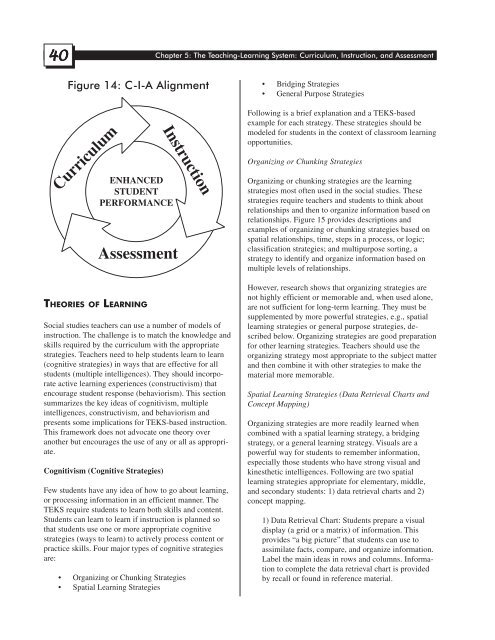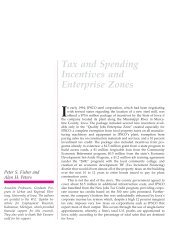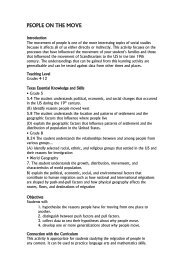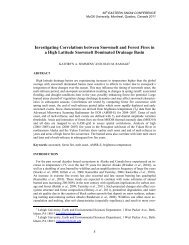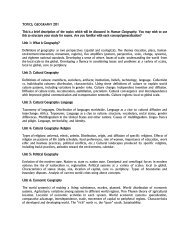Texas Social Studies Framework - Department of Geography ...
Texas Social Studies Framework - Department of Geography ...
Texas Social Studies Framework - Department of Geography ...
You also want an ePaper? Increase the reach of your titles
YUMPU automatically turns print PDFs into web optimized ePapers that Google loves.
40<br />
40<br />
Figure 14: C-I-A Alignment<br />
Curriculum<br />
ENHANCED<br />
STUDENT<br />
PERFORMANCE<br />
Assessment<br />
THEORIES OF LEARNING<br />
<strong>Social</strong> studies teachers can use a number <strong>of</strong> models <strong>of</strong><br />
instruction. The challenge is to match the knowledge and<br />
skills required by the curriculum with the appropriate<br />
strategies. Teachers need to help students learn to learn<br />
(cognitive strategies) in ways that are effective for all<br />
students (multiple intelligences). They should incorporate<br />
active learning experiences (constructivism) that<br />
encourage student response (behaviorism). This section<br />
summarizes the key ideas <strong>of</strong> cognitivism, multiple<br />
intelligences, constructivism, and behaviorism and<br />
presents some implications for TEKS-based instruction.<br />
This framework does not advocate one theory over<br />
another but encourages the use <strong>of</strong> any or all as appropriate.<br />
Cognitivism (Cognitive Strategies)<br />
Few students have any idea <strong>of</strong> how to go about learning,<br />
or processing information in an efficient manner. The<br />
TEKS require students to learn both skills and content.<br />
Students can learn to learn if instruction is planned so<br />
that students use one or more appropriate cognitive<br />
strategies (ways to learn) to actively process content or<br />
practice skills. Four major types <strong>of</strong> cognitive strategies<br />
are:<br />
• Organizing or Chunking Strategies<br />
• Spatial Learning Strategies<br />
Chapter 5: The Teaching-Learning System: Curriculum, Instruction, and Assessment<br />
Instruction<br />
• Bridging Strategies<br />
• General Purpose Strategies<br />
Following is a brief explanation and a TEKS-based<br />
example for each strategy. These strategies should be<br />
modeled for students in the context <strong>of</strong> classroom learning<br />
opportunities.<br />
Organizing or Chunking Strategies<br />
Organizing or chunking strategies are the learning<br />
strategies most <strong>of</strong>ten used in the social studies. These<br />
strategies require teachers and students to think about<br />
relationships and then to organize information based on<br />
relationships. Figure 15 provides descriptions and<br />
examples <strong>of</strong> organizing or chunking strategies based on<br />
spatial relationships, time, steps in a process, or logic;<br />
classification strategies; and multipurpose sorting, a<br />
strategy to identify and organize information based on<br />
multiple levels <strong>of</strong> relationships.<br />
However, research shows that organizing strategies are<br />
not highly efficient or memorable and, when used alone,<br />
are not sufficient for long-term learning. They must be<br />
supplemented by more powerful strategies, e.g., spatial<br />
learning strategies or general purpose strategies, described<br />
below. Organizing strategies are good preparation<br />
for other learning strategies. Teachers should use the<br />
organizing strategy most appropriate to the subject matter<br />
and then combine it with other strategies to make the<br />
material more memorable.<br />
Spatial Learning Strategies (Data Retrieval Charts and<br />
Concept Mapping)<br />
Organizing strategies are more readily learned when<br />
combined with a spatial learning strategy, a bridging<br />
strategy, or a general learning strategy. Visuals are a<br />
powerful way for students to remember information,<br />
especially those students who have strong visual and<br />
kinesthetic intelligences. Following are two spatial<br />
learning strategies appropriate for elementary, middle,<br />
and secondary students: 1) data retrieval charts and 2)<br />
concept mapping.<br />
1) Data Retrieval Chart: Students prepare a visual<br />
display (a grid or a matrix) <strong>of</strong> information. This<br />
provides “a big picture” that students can use to<br />
assimilate facts, compare, and organize information.<br />
Label the main ideas in rows and columns. Information<br />
to complete the data retrieval chart is provided<br />
by recall or found in reference material.


